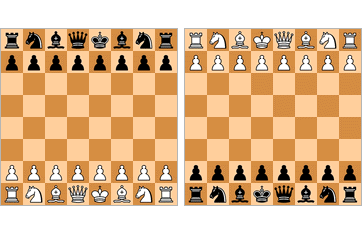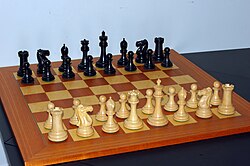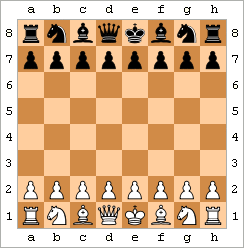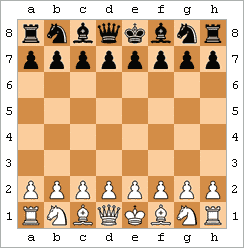A
- absolute pin
- A pin against the king is called absolute since the pinned piece cannot legally move out of the line of attack (as moving it would expose the king to check). [1]
Cf. relative pin . - active
- Describes a piece that threatens a number of squares, or that has a number of squares available for its next move. It may also describe an aggressive style of play. [2]
Antonym: passive - adjournment
- Suspension of a chess game with the intention to finish it later. It was once very common in high-level competition, often occurring soon after the first time control, but has been mostly abandoned due to the advent of computer analysis. [3]
- adjudication
- A way to decide the result of an unfinished game. A tournament director, or an impartial and strong player, will evaluate the final position and assign a win, draw, or loss assuming best play by both players. [4]
- adjust
- See touch-move rule. To adjust the position of a piece on its square without being required to move it. A player may do this only on their turn, and must first say "I adjust", or the French equivalent "J'adoube". [5]
- advanced pawn
- A pawn that is on the opponent's half of the board (the fifth rank or higher for White; the fourth rank or lower for Black). An advanced pawn may be weak if it is overextended, lacking support and difficult to defend, or strong if it cramps the enemy by limiting mobility. An advanced passed pawn that threatens to promote can be especially strong. [6]
- advantage
- A better position with the chance of winning the game. Evaluation factors can include space, time, material, and threats. [2]
- Alekhine's gun
- A special form of battery in which a queen backs up two rooks on the same file. [7]
- algebraic notation ("AN")
- The standard way to record the moves of a chess game, using alphanumeric coordinates for the squares. [8] Also called standard notation. [9]
- amateur
- Any player whose main occupation is not chess. [10] The distinction between professional and amateur is not very important in chess as amateurs may win prizes, accept appearance fees, and earn any title, including World Champion. [10] [11] In the 19th century, "Amateur" was sometimes used in published game scores to conceal the name of the losing player in a Master vs. Amateur contest. It was thought to be impolite to use a player's name without permission, and the professional did not want to risk losing a customer. [9]
- analysis
- The study of a game or a position, in order to evaluate the quality of the moves and various other aspects of the game or position. At the end of a game, the players will often do an analysis of the game. [2]
- annotation
- Written commentary on a game or a position using words, chess symbols, or notation. [2]
- announced mate
- A practice, common in the 19th century, whereby a player would announce a sequence of moves, believed by them to constitute best play by both sides, that led to a forced checkmate for the announcing player in a specified number of moves (for example, "mate in five"). [12]
- antipositional
- A move or a plan that is not in accordance with the principles of positional play. [13] Antipositional is used to describe moves that are part of an incorrect plan rather than a mistake made when trying to follow a correct plan. Antipositional moves are often pawn moves; since pawns cannot move backwards to return to squares they have left, their advance can create irreparable weaknesses. [14]
- Anti-Sicilian
- An opening variation that White uses against the Sicilian Defense (1.e4 c5) other than the most common plan of 2.Nf3 followed by 3.d4 cxd4 4.Nxd4 (the Open Sicilian). Some Anti-Sicilians include the Alapin Variation (2.c3), Moscow Variation (2.Nf3 d6 3.Bb5+), Rossolimo Variation (2.Nf3 Nc6 3.Bb5), Grand Prix Attack (2.Nc3 Nc6 3.f4 g6 4.Nf3 Bg7 and now 5.Bc4 or 5.Bb5), Closed Sicilian (2.Nc3 followed by g3 and Bg2), Smith–Morra Gambit (2.d4 cxd4 3.c3), and Wing Gambit (2.b4). [15]
- Arabian mate
- A checkmate that occurs when the knight and rook trap the opposing king in a corner. [16]
- arbiter
- An official responsible for overseeing chess tournaments and ensuring that the rules of chess are obeyed.
- arena
- A type of tournament without a fixed amount of rounds. [17]
- Armageddon game
- A game that is guaranteed to produce a decisive result, because if there is a draw it is ruled a victory for Black. In compensation for this White is given more time on the clock. Often White is given five minutes, and Black four. This format is typically used in playoff tiebreakers when shorter blitz games have not resolved the tie. [18]
- artificial castling
- Also known as castling by hand.
Refers to a maneuver of several separate moves by the king and by a rook where they end up as if they had castled. [19] - attack
- An aggressive action on a part of the chessboard, or to threaten the capture of a piece or pawn. [20]
Antonym: defense . - attraction
- A type of decoy involving a sacrifice of a minor or major piece on a square next to the enemy king, forcing the king to abandon the defense of another square. For example (see diagram), the black queen has interposed to block a check from the white queen, and White can check the king from the opposite direction to win the queen. [21]
- automaton
- An automaton is a self-operating machine. In chess, it refers to chess-playing machines that were in fact hoaxes and under the control of hidden human players. Automatons stirred up great interest in the 18th and 19th centuries and inspired early thoughts of the possibility of artificial intelligence. By far, the most famous chess-playing "automaton" was The Turk, whose secret of human control was kept for a long time. The first true automaton El Ajedrecista was created by Leonardo Torres y Quevedo.

Alekhine vs. Nimzowitsch, 1930
| a | b | c | d | e | f | g | h | ||
| 8 |  | 8 | |||||||
| 7 | 7 | ||||||||
| 6 | 6 | ||||||||
| 5 | 5 | ||||||||
| 4 | 4 | ||||||||
| 3 | 3 | ||||||||
| 2 | 2 | ||||||||
| 1 | 1 | ||||||||
| a | b | c | d | e | f | g | h | ||
Alekhine's gun

| a | b | c | d | e | f | g | h | ||
| 8 |  | 8 | |||||||
| 7 | 7 | ||||||||
| 6 | 6 | ||||||||
| 5 | 5 | ||||||||
| 4 | 4 | ||||||||
| 3 | 3 | ||||||||
| 2 | 2 | ||||||||
| 1 | 1 | ||||||||
| a | b | c | d | e | f | g | h | ||
Arabian mate
| a | b | c | d | e | f | g | h | ||
| 8 |  | 8 | |||||||
| 7 | 7 | ||||||||
| 6 | 6 | ||||||||
| 5 | 5 | ||||||||
| 4 | 4 | ||||||||
| 3 | 3 | ||||||||
| 2 | 2 | ||||||||
| 1 | 1 | ||||||||
| a | b | c | d | e | f | g | h | ||
White wins with 1.Rd7+! The black king is attracted away from the defense of the black queen with a skewer.











